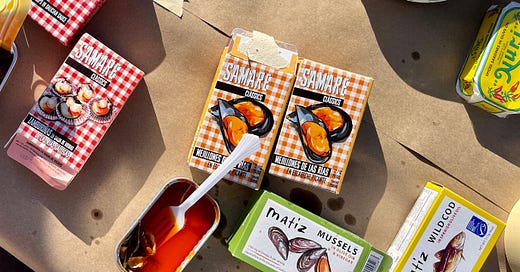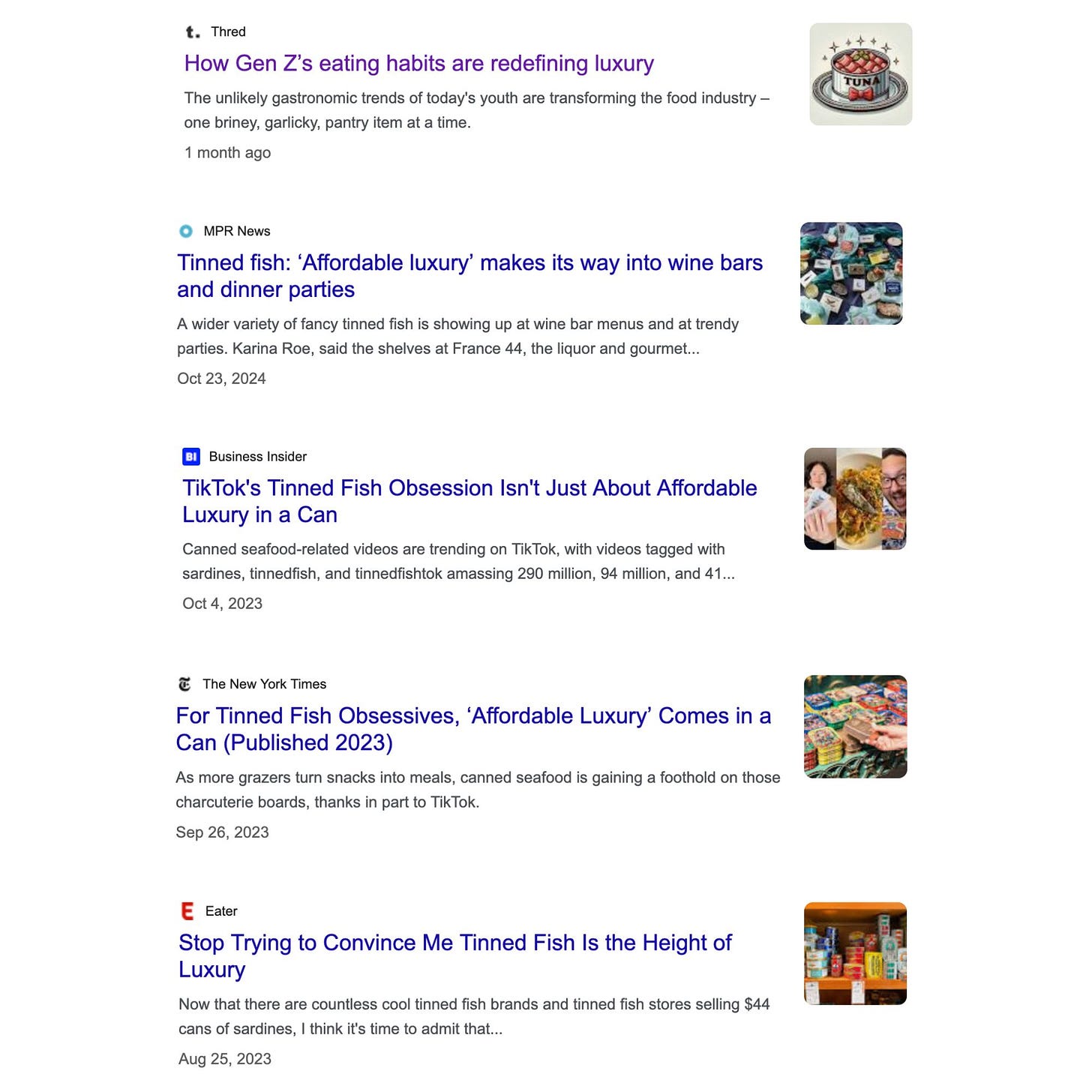The paradox of affordable luxury and canned fish
Why is tinned fish so expensive? And please stop calling it hot girl food.
Food is the oldest luxury.
It’s the first thing people fight over in times of scarcity, and the first thing we share in times of celebration. It may be assumed, accessible, often invisible in its importance. But food has always been a luxury. Even when it didn’t feel like one. Before the pandemic, before shrinkflation snuck into chip bags and egg prices tripled, food insecurity affected fewer households. In 2022, food prices increased by 9.9 percent, faster than in any year since 1979.1
Now, with global inflation pressing into the corners of everyday life, we’re seeing food for what it is: essential, and increasingly, out of reach. From vegetable centerpieces to celebrity grocery hauls to social media darlings like Nara Smith and Ballerina Farm—food commands attention.


The lipstick of the pantry aisle
Many articles have coined canned fish an “affordable luxury”. An analysis from Persistence Market Research identifies it a quickly growing segment in the United States is predicted to reach $17.2 billion by the end of 2033, up from $9.5 billion in 2022.2
The phrase “affordable luxury” is a paradox by design—something positioned as indulgent, yet within reach. But the semantics are slippery. What’s “affordable” to one person might be a stretch for another, and the idea that luxury should be democratized often overlooks who’s still left out.
This framing reveals a growing consumer trend in premium canned fish. According to the Economist, in America sales of premium tinned fish (defined as anything exceeding $5 a can) are growing at triple the rate of the broader market.3
The economic concept of the lipstick effect was coined by Leonard Lauder, who saw a rise in his company’s lipstick sales during the early 2000s recession.4 He hypothesized when recessions hit, consumers tend to shy away from big luxury items—designer bags, watches, international vacations. But small indulgences? A $7 bar of dark chocolate, a $6 matcha latte, a $10 tin of smoked mackerel in olive oil could fly.
While this effect was later discredited as a wider economic indicator, it provides an interesting hypothesis for the explosive popularity of canned seafood. When everything feels uncertain, these “little luxuries” help people feel like they haven’t completely lost agency or joy. They provide a sense of abundance without the guilt of a big-ticket spend. They feel luxurious, even if they’re part of something mundane like lunch. That afternoon sweet treat? It taps into a part of the consumer market that’s willing to splurge on something tied to a necessity, like food.5
During the pandemic, a fancy restaurant meal or international vacation wasn’t an option, so why not trade it for French sardines, pour a glass of wine, and pretend you're in Cannes. Sure canned fish is a protein source (and boy do I have thoughts on the consumer obsession with protein), but it also becomes a curated lifestyle item.
Post-pandemic US tourists flooded Spain and Portugal. Forbes notes an 89.9% increase in American tourists’ spending in Spain for August 2024 compared to August 2019.6 With this surge in tourism, Americans are bringing back expensive canned fish as souvenirs. It’s a tiny piece of Europe that fits in your pantry.
Can we stop calling it hot girl food?
Canned fish is not a new discovery and it’s not trendy to everyone. For working-class folks and immigrants it's been a pantry staple long before anyone started calling it “hot girl food.”
And look—I get the intent. It’s playful. It’s meant to signal that women are adventurous or healthy, perhaps they’re reclaiming foods that were once considered low-brow. But personally? This branding rubs me the wrong way. What once made someone “other” becomes cool once filtered through a more palatable, often white lens. I have yet to see an enthusiastic “hot girl” Instagram spread for a tin of Titus hot sardines or Eagle Coin dace.
Canned fish has roots in survival, migration, war-time rationing, and blue-collar kitchens. It’s a cornerstone of food cultures that knew how to make the most out of scarcity. In the US, canned fish was critical during wartime. However, by the 1940s, overfishing had begun to render many canneries obsolete.
At the same time, calling it “hot girl food” discredits the craftsmanship of an equal and opposite tradition of canneries who’ve honed this preservation method over generations. We’re not talking Cannery Row in WWII California here, I’m thinking about canneries like Real Conservera or Yurrita in Spain whose techniques are refined over generations. Premium canned fish is far from new, it’s only new to the American food zeitgeist.
The cheese analogy
As someone who eats a hundreds of cans of fish online and is likely fueling the interest in canned fish, I’ve also seen dozens of stitches and criticism about “gentrified canned fish”.
People are often shocked to learn that a can of fish can cost $15. In the US, canned sardines and seafood have long been framed as commodity foods: cheap, practical, and forgettable. I blame Cloudy With A Chance of Meatballs for fearmongering.
The simplest way I’ve found to explain this is through cheese.
We can accept that Kraft singles and a 14-month cave-aged Gruyère from Switzerland are both cheese. One is made quickly in mass quantities while the other is the result of specific procedures in sourcing and aging.
It’s the same with canned fish. A $1 tin of sardines in soybean oil and a $25 tin in cold-pressed Arbequina olive oil might use the same species of fish, but how they’re harvested, preserved, and packed makes a difference.
Simultaneously, I find it unfair to imply that canned fish has moral hierarchies because not everyone has the same access to it. It’s fair to say my interest in fancy canned seafood reflects socioeconomic privilege more than personal virtue. $2 kippers are no less “good” than a $20 tin of tuna ventresca from Spain.
There’s a tremendous amount of nuance in how tinned fish is made and why it costs what it does. For most Americans, the idea of tinned fish still conjures up images of cheap canned tuna or sardines. The sticker shock upon seeing an expensive tin of tuna makes sense. This tension fuels a kind of canned fish pretentiousness: a cultural moment where the product is elevated in some circles as a marker of social capital, while for many others, it remains a practical, unglamorous food.
So, who is canned fish really for?
It’s what got me through being a full-time student while holding down a full-time job. I needed something shelf-stable, quick, and nutritious.
As a kid, fried dace was a convenient and cheap flavor booster seen in our weeknight meals. When my father was in college, that same can of fried dace was a real splurge that demanded you soak up every drop of its flavorful oil with rice. The contradiction of 'affordable luxury' extends to me—I went from cracking tins as a student struggle meal to becoming the tinned fish equivalent of a natural wine evangelist (I swear the funk is good!)
But also for the climate-conscious eater looking for low-impact protein.
For health hackers calcium and omega-3-maxxing.
For collage artists collecting just the packaging.
For the food snob building a tinned fish board with pickled peppers and marcona almonds.
For the adventurous soul who simply wants to try something new.
But even that’s starting to shift.
Consumer interest in canned fish is at its highest in decades. As venture capital enters this category and tariffs reshape supply, maybe it’s time we stop asking who canned fish is for and consider who benefits most from this surge in popularity?
https://www.ers.usda.gov/data-products/food-price-outlook/summary-findings
https://www.openpr.com/news/3870010/tinned-fish-market-size-to-reach-usd-17-2-bn-by-2033-driven
https://www.economist.com/culture/2024/07/30/tinned-fish-is-swimming-against-the-tide
https://www.forbes.com/sites/pamdanziger/2022/06/01/with-inflation-rising-the-lipstick-effect-kicks-in-and-lipstick-sales-rise/
https://adage.com/article/digital-marketing-ad-tech-news/gen-z-little-treat-culture-influences-glossier-dove-diet-coke-marketing/2605176/
https://www.forbes.com/sites/isabellekliger/2025/02/03/why-us-travelers-are-spending-more-than-ever-in-spain/









I love your work and as a low income person I appreciate this article! I would have to disagree with calling Kraft Singles cheese though.
Great piece! Would love to hear your thoughts on the protein trend.